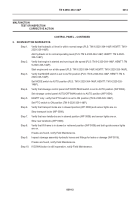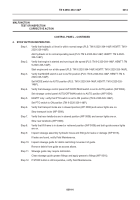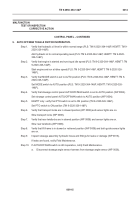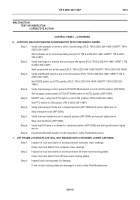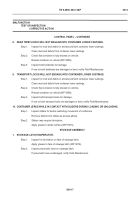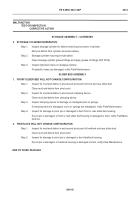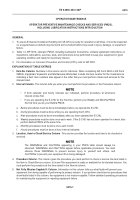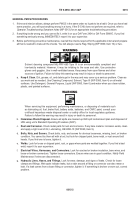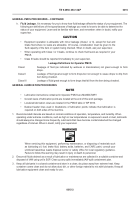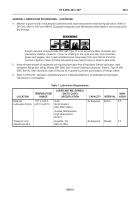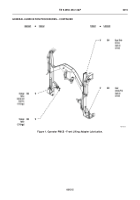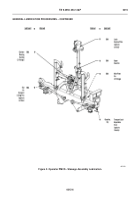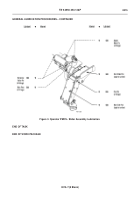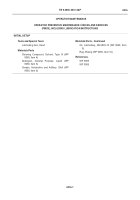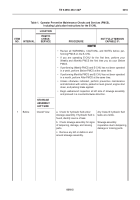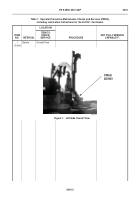TB-9-3950-253-13-P
PALLETIZED LOAD SYSTEM TRUCK, M1075 and M1075A1 (PLS) AND HEAVY EXPANDED MOBILITY TACTICAL TRUCK, M1120, M1120A2, AND M1120A4 (HEMTT), ENHANCED CONTAINER HANDLING UNIT (E-CHU)
TECHNICAL BULLETIN; OPERATOR AND FIELD MAINTENANCE, INSTALLATION INSTRUCTIONS, AND REPAIR PARTS AND SPECIAL TOOLS LIST
JULY 2009
TB-9-3950-253-13-P - Page 138 of 704
TB 9-3950-253-13&P
0015-2
0015
GENERAL PMCS PROCEDURES
00015
1. If time and mission allows, always perform PMCS in the same order so it gets to be a habit. Once you have had
some practice, you will spot anything wrong in a hurry. If the E-CHU does not perform as required, refer to
Operator
Troubleshooting Symptom Index
(WP 0013) for an appropriate troubleshooting procedure.
2. If anything looks wrong and you cannot fix it, write it on your DA Form 2404 or DA Form 5988-E. If you find
something seriously wrong, IMMEDIATELY report it to your supervisor.
3. Before performing preventive maintenance, read all the checks required for the applicable interval and prepare
all that is needed to make all the checks. You will always need a Rag, Wiping (WP 0060, Item 10) or two.
WARNING
Solvent cleaning compound MIL-PRF-680 Type III is an environmentally compliant and
low-toxicity material. However, it may be irritating to the eyes and skin. Use protective
gloves and goggles. Use in well-ventilated areas. Keep away from open flames and other
sources of ignition. Failure to follow this warning may result in injury or death to personnel.
a.
Keep It Clean.
Dirt, grease, oil, and debris get in the way and may cover up a serious problem. Clean as
you work and as needed. Use Cleaning Compound, Solvent, Type III (WP 0060, Item 4) on all metal
surfaces. Use Detergent, General Purpose, Liquid (WP 0060, Item 6) and water when you clean rubber,
plastic, and painted surfaces.
WARNING
When servicing this equipment, performing maintenance, or disposing of materials such
as lubricating oil, fuel, brake fluid, battery acids, batteries, and CARC paint, consult your
unit/local hazardous waste disposal center or safety office for local regulatory guidance.
Failure to follow this warning may result in injury or death to personnel.
b.
Hazardous Waste Disposal.
Ensure all spills are cleaned up IAW spill containment plan and disposed of
IAW using unit’s Standard Operating Procedure (SOP).
c.
Rust and Corrosion.
Check metal parts for rust and corrosion. If any bare metal or corrosion exists, clean
and apply a light coat of Oil, Lubricating, OE/HDO-10 (WP 0060, Item 9).
d.
Bolts, Nuts, and Screws.
Check bolts, nuts, and screws for obvious looseness, missing, bent, or broken
condition. You cannot try them all with a tool, but look for chipped paint, bare metal, or rust around bolt
heads. If you find one is loose, tighten it.
e.
Welds.
Look for loose or chipped paint, rust, or gaps where parts are welded together. If you find a bad
weld, report it to your supervisor.
f.
Electrical Wires, Harnesses, and Connectors.
Look for cracked or broken insulation, bare wires, and
loose or broken connectors. Tighten loose connectors. Ensure wires are in good condition. Notify Field
Maintenance if wires are disconnected.
g.
Hydraulic Lines, Hoses, and Fittings.
Look for wear, damage, and signs of leaks. Check for loose
clamps and fittings. Wet spots indicate leaks, but a stain around a fitting or connector can also mean a
leak. If a leak comes from a loose fitting or connector, tighten it. If something is broken or worn out, correct
problem.
Back to Top


